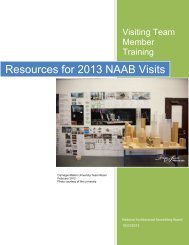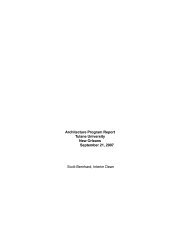NAAB Architecture Program Report (APR) 2013 - Tulane School of ...
NAAB Architecture Program Report (APR) 2013 - Tulane School of ...
NAAB Architecture Program Report (APR) 2013 - Tulane School of ...
Create successful ePaper yourself
Turn your PDF publications into a flip-book with our unique Google optimized e-Paper software.
<strong>Tulane</strong> University<strong>Architecture</strong> <strong>Program</strong> <strong>Report</strong>September <strong>2013</strong>D. Architectural Education and the Pr<strong>of</strong>ession.<strong>Tulane</strong> <strong>School</strong> <strong>of</strong> <strong>Architecture</strong> blends instruction in the traditional practice <strong>of</strong>architecture with attention toward emerging opportunities and “non-traditional” careerpaths that students increasingly choose to pursue. For example, Public Interest Designis a national trend for students who wish to operate in the public realm, just as lawyershave moved into public policy and advocacy roles for many years. <strong>Tulane</strong>’scommitment involving community engagement inspires students to think about howthey are broadly preparing themselves for the fast-changing nature <strong>of</strong> practice in aglobal economy, including an awareness <strong>of</strong> the role <strong>of</strong> clients both traditionallyconceived and the community as client. Understanding the multiple needs <strong>of</strong> diversepopulations is fundamental to any community-based practice, and our students arefortunate to gain tangible experience in this area while they are in school. Given thefragile ecosystem <strong>of</strong> our region and the challenging climate, students are attuned to theimportance <strong>of</strong> design in relation to environmental conditions. They are also aware <strong>of</strong>the interplay between built and natural environments through design and infrastructuralinterventions.E. Architectural Education and the Public Good.Civic engagement has been the hallmark <strong>of</strong> <strong>Tulane</strong> University from the moment theinstitution re-opened after the devastation <strong>of</strong> Hurricane Katrina. Just over four monthsafter August 29, 2005, the University resumed instruction dedicated to more than justrebuilding the campus itself. <strong>Tulane</strong> embraced the proposition <strong>of</strong> helping to create abetter city as the largest private employer in New Orleans – to come back better andstronger than before the storm. The <strong>School</strong> <strong>of</strong> <strong>Architecture</strong> has been a highly visibleexemplar <strong>of</strong> the value <strong>of</strong> the “<strong>Tulane</strong> Recovery Plan”, with heroic work on the part <strong>of</strong>many students and faculty over the past seven and a half years. Real worldexperiences through community engagement and public service are fundamental in ourprogram, and we believe that this positions students uniquely for importantcontributions throughout their careers. Many faculty members are tremendous rolemodels for these values and have gained local and national recognition for theircontributions in this regard.I.1.4. Long Range PlanningThe <strong>School</strong> <strong>of</strong> <strong>Architecture</strong> has been engaged in planning as a continuous process. Faculty input hasbeen key to the progress we have seen over the past five years. The most recent iteration <strong>of</strong> thisprocess can be seen in the adopted Strategic Plan 2.1.STRATEGIC PLAN 2.1 (April 18, <strong>2013</strong>)<strong>Tulane</strong> <strong>School</strong> <strong>of</strong> <strong>Architecture</strong>“The trouble with our times is that the future is not what it used to be.” Paul Valéry, OeuvresIntroductionThe Strategic Plan 2.1 is an update <strong>of</strong> the strategic plan from the summer <strong>of</strong> 2008 with substantialfaculty input led by Associate Dean Wendy Redfield during 2012-<strong>2013</strong>. These contributions werecollected and compiled into the extant document. The original 2008 plan also received extensive inputand refinements during the fall semester <strong>of</strong> that year by the faculty and Board <strong>of</strong> Advisors. Theprevious 2008 plan included three main priorities and a number <strong>of</strong> tactics for their attainment:• Strengthen the core• Raise the pr<strong>of</strong>ile• Engage the community9














